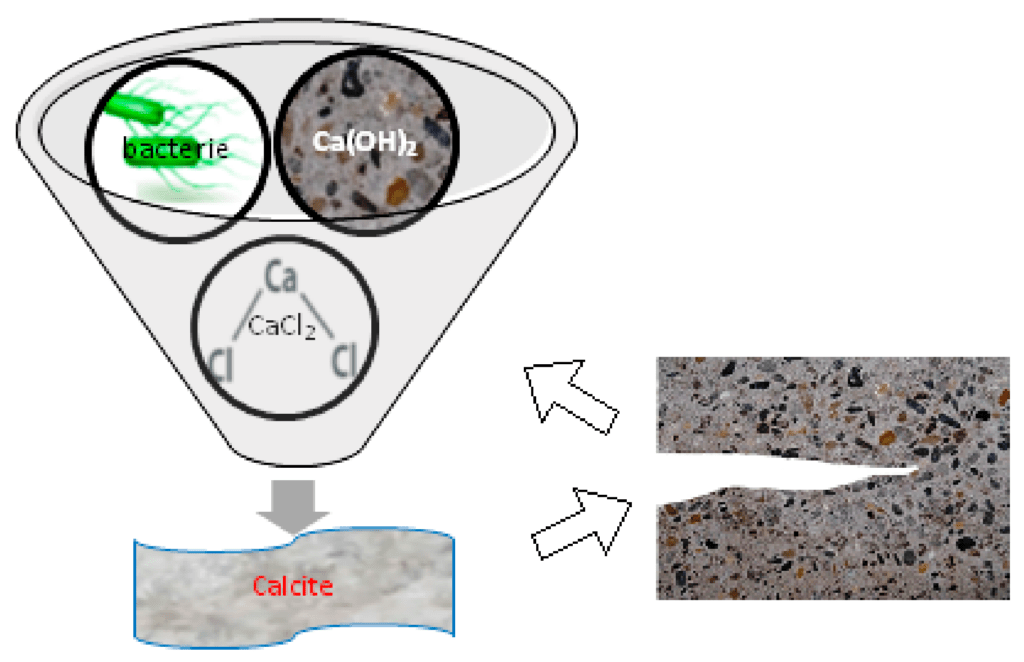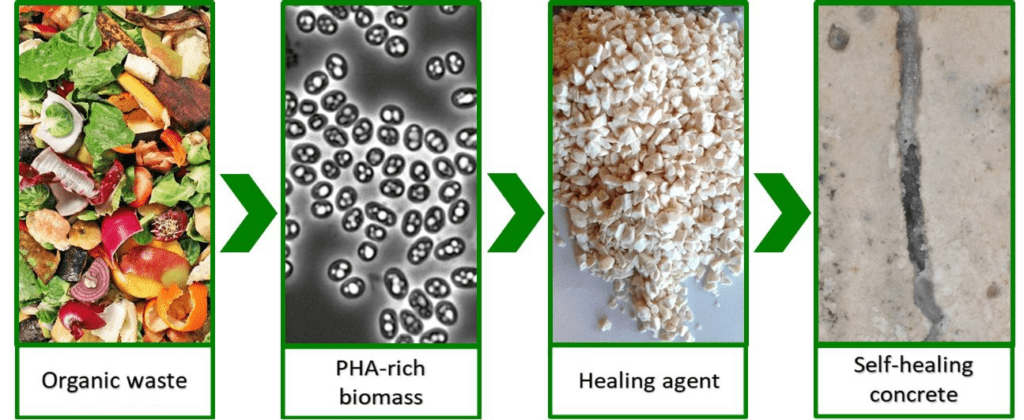Nature’s smallest engineers are taking center stage in construction, offering a revolutionary solution to one of the industry’s most pressing challenges: concrete waste. By increasing the longevity of building materials, bacteria are driving a paradigm shift toward circularity in construction.
The Science of Self-Healing Concrete
Concrete is one of the most widely used materials in the world, but it’s not invincible. Over time, cracks form due to environmental stress, requiring costly and resource-intensive maintenance. Enter bacteria—nature’s microscopic masons.
Dormant bacteria embedded in concrete mix awaken when cracks form and water seeps in. These bacteria then produce limestone, effectively healing the damage. This process not only strengthens the material but also reduces the need for repairs.
Why It Matters
Here’s why this innovation is a game-changer:
- Reduced Waste: Self-healing concrete could save millions of tons of concrete waste annually, significantly lowering the environmental impact of the construction industry.
- Cost Efficiency: A single application of bacterial concrete can cut repair costs by up to 50%, offering a sustainable and economical solution.
- Rapid Healing: Cracks up to 0.8mm wide can be fully repaired in as little as three weeks, minimizing downtime and ensuring structural integrity.

Building a Circular Economy
This breakthrough aligns perfectly with the principles of a circular economy, where materials are reused and waste is minimized. By extending the lifespan of concrete structures, we can reduce the demand for new materials, conserve resources, and decrease CO2 emissions associated with cement production.
Inspiration for the Future
The concept of bacteria healing concrete is just the beginning. Innovations like these highlight the potential of biomimicry in solving modern challenges. As we continue to explore nature’s solutions, the possibilities for creating sustainable industries are endless.

Exploring Sustainability Benefits
While the above sections provide a brief overview of the topic, let’s dive deeper into the sustainability benefits of self-healing concrete in more detail.
1. Environmental Impact Reduction
One of the most significant sustainability benefits of self-healing concrete is the reduction in environmental impact. Traditional concrete production is a major contributor to CO2 emissions, as the manufacturing process involves the calcination of limestone, which releases carbon dioxide. By extending the lifespan of concrete structures through self-healing technology, the demand for new concrete is reduced, leading to lower CO2 emissions.
Additionally, the reduction in concrete waste means fewer materials are sent to landfills, further decreasing the environmental footprint. The use of bacteria to repair concrete also eliminates the need for chemical-based repair materials, which can be harmful to the environment.
2. Resource Conservation
Self-healing concrete contributes to resource conservation by minimizing the need for raw materials used in repairs. Traditional concrete repair methods often involve the use of additional cement, aggregates, and other materials, which deplete natural resources. By utilizing bacteria to repair cracks, the need for these materials is significantly reduced.
Moreover, the production of new concrete requires substantial amounts of water. By reducing the frequency of repairs and replacements, self-healing concrete helps conserve water resources, which is particularly crucial in regions facing water scarcity.
3. Longevity and Durability
The inherent durability of self-healing concrete enhances the lifespan of structures. Traditional concrete is susceptible to damage from environmental factors such as freeze-thaw cycles, chloride ingress, and sulfate attacks. These factors can lead to the deterioration of concrete over time, necessitating frequent repairs.
Self-healing concrete, on the other hand, provides a more resilient solution. The bacteria within the concrete continuously work to repair cracks as they form, ensuring that the material remains robust and durable for an extended period. This longevity translates to fewer repairs and replacements, reducing the overall environmental impact.
4. Economic Benefits
The economic benefits of self-healing concrete are substantial. The construction industry incurs significant costs related to the maintenance and repair of concrete structures. Traditional repair methods can be labor-intensive, time-consuming, and costly. By adopting self-healing concrete, these costs can be significantly reduced.
The initial investment in self-healing concrete may be higher than traditional concrete, but the long-term savings in maintenance and repair costs make it a cost-effective solution. Furthermore, the reduced downtime associated with rapid crack healing means that structures can remain operational for longer periods, contributing to increased productivity and economic efficiency.
5. Innovation and Technological Advancement
The development and implementation of self-healing concrete represent a significant advancement in construction technology. This innovation paves the way for further research and development in the field of biomimicry and sustainable construction materials.
As scientists and engineers continue to explore the potential of self-healing concrete, new and improved formulations may emerge, enhancing its effectiveness and expanding its applications. This ongoing innovation drives progress in the construction industry, promoting the adoption of sustainable practices and materials.
6. Health and Safety Benefits
Concrete repair and maintenance activities can pose health and safety risks to workers. Traditional repair methods often involve the use of hazardous chemicals, heavy machinery, and labor-intensive processes, which can lead to injuries and health issues.
Self-healing concrete reduces the need for such repair activities, thereby minimizing the exposure of workers to hazardous conditions. The automated nature of the self-healing process ensures that repairs are carried out efficiently and safely, without the need for extensive human intervention.
7. Adaptability to Various Environments
Self-healing concrete is adaptable to a wide range of environmental conditions. Whether used in urban infrastructure, coastal regions, or areas with extreme weather conditions, self-healing concrete can withstand various stressors and maintain its structural integrity.
This adaptability makes self-healing concrete a versatile solution for diverse construction projects. It can be used in the construction of bridges, roads, buildings, and other critical infrastructure, contributing to the resilience and sustainability of these structures.
Conclusion
Self-healing concrete represents a groundbreaking innovation in the construction industry, offering numerous sustainability benefits. By reducing waste, conserving resources, enhancing durability, and providing economic advantages, self-healing concrete aligns with the principles of a circular economy and promotes sustainable construction practices.
The potential of self-healing concrete extends beyond its current applications, inspiring further research and development in biomimicry and sustainable materials. As we continue to explore and adopt nature-inspired solutions, the construction industry can move toward a more sustainable and environmentally friendly future.

Related Content
- Harald Friedl – circulareconomy #innovation #zerowaste
- Top 5 Must-See Attractions in Gran Canaria + Stay at the Eco-Friendly Lopesan Villa del Conde Resort
- CD BioSciences Pioneers Sustainable Solutions with Revolutionary Product Launch
- A Comprehensive Look at Two Innovative Renewable Energy Projects: Solar Highways and the Western Green Energy Hub
- Bamboo: The Eco-Friendly Wonder Material Transforming Modern Design
- Megabasins: A Band-Aid or a Long-Term Solution for Climate Change?
- EU’s Significant Climate Progress: A Step Towards a Sustainable Future
- Can Self-Healing Concrete Revolutionize Sustainability
- Influence of self-healing behavior of bacteria & e-waste
- The Use of Self-Healing Concrete in Modern Construction
